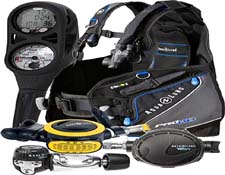

|


|
 |
 |
 |
 |
 |
 |
 |
 |



|
Diving Highlights
Manta Rays at Socorro Island As a lonely seamount far offshore, Socorro Island attracts a large number of pelagic species, among them are large groups of giant manta rays. Cenote Diving in Yucatan Hundreds of crystal clear cenotes (caves) can be found throughout Mexico. Cenote Dos Ojos near Tulum is the most famous and is easily accessible to most divers. Bull Sharks in Playa del Carmen From November to March, large bull shark females arrive in Playa del Carmen in order to breed. Get up close and personal with these amazing sharks. El Museo Subaquàtico de Arte (MUSA) The MUSA, located next to Cancun, is an underwater contemporary museum of art consisting of over 500 permanent life-size sculptures from English artist Jason deCaires Taylor. Whale Sharks in Isla Mujeres Isla Mujeres, just off-shore from Cancun, sits at the join of the Gulf of Mexico and the Caribbean. As such, it attracts hundreds of Whale Sharks from June to September each year. Sea Lions at Isla San Pedro More than 400 sea lions call the Sea of Cortez home. You’ll find playful babies on most dives in the area, but Isla San Pedro is our favorite site. Great White Sharks in Guadalupe Every year from August to October, divers make the pilgrimage to this tiny island out in the Pacific in order to cage dive with Great White Sharks. Diving In Mexico Mexico’s two coasts are ripe for underwater exploration. You can discover the vast kelp forests of the Pacific, the hidden reefs of the Sea of Cortez and the Yucatan peninsula, and shipwrecks in the Caribbean. Pelagic-lovers will also be pleased with Mexico’s breeding grounds and sites boasting heavy currents. Not all of the dives in Mexico are out in the salty seas. During your time in the Yucatan be sure to dive in the crystal clear cenotes. The most popular, and rightly so, is the Cenote Dos Ojos. From beginners to tec divers, there are dives for every level in Mexico. The Yucatan and the east side of Baja California are generally protected from heavy current, creating good dive sites for beginners. However, offshore islands like Guadalupe and Socorro Island should only be attempted by advanced divers due to their raging currents. Furthermore, some of the cenotes require technical diving skills. Diving in Mexico mainly takes place from speedboats. It is possible to dive some of the Sea of Cortez and the Caribbean’s reefs as well as the cenotes from shore. Guadalupe and Socorro must be accessed by liveaboard vessel. While a reef hook may be helpful in some areas, they are not permitted in protected areas. A 16% tax is levied on all diving activities in Mexico. When To Go The Caribbean can be dived year-round. If Socorro is your destination, book from November to May. If Guadalupe is on your list, go between August and October. November to May November to May is considered the best time to dive in Socorro Island. Liveaboards set sail for this remote island at this time, because the sea conditions in the Pacific are calmest during these months. The weather is generally sunny with occasional rain showers. Manta rays can be seen throughout the year in Socorro, but during the winter months, divers also have the chance of spotting a whale shark or one of the thousands of humpbacks that breed and calve in the area. At this time, visibility is negatively impacted is by plankton blooms. These are most common around the full moon. If you’re headed to Socorro and want the best conditions for manta ray diving, book your holiday between November and May. Elsewhere in Mexico, November to May is considered high season for general tourism, causing an increase in accommodation rates throughout the country. This season is also the best season for Bull Sharks near Playa del Carmen. May to September The best time for cenote diving is between May and September. These months bring the best light to the caves and result in the better photographs. Also note that diving on the Caribbean side of Mexico is possible year-round. Simply keep an eye on the forecast during the summer and early fall. These seasons do see the occasional hurricane. When there isn’t a hurricane, the weather during the summer is hot and humid with the occasional rain shower. June to September in particular is best for whale sharks near Isla Mujeres. As an added bonus, the summer months are low season throughout Mexico. At this time, you’ll find the best deals on diving and accommodation. If you enjoy uncrowded, Caribbean dive sites, travel to Mexico between May and September. August to October August to October is Guadalupe liveaboard season. During these months, the coldest water temperatures arrive with an average surface temperature of just 66°F to 70°F (19°C to 22°C). These temperatures attract the Great White Sharks making this the best time to dive in Guadalupe. August to November is also the season for liveaboard diving in the Sea of Cortez. While Guadalupe is cold, the Sea of Cortez is at its warmest. The water is approximately 80°F (27°C) and these are the best months for hammerhead encounters in the region. The weather at this time transitions from hot and humid to cooler with a bit of rain. On the other hand, August to October is not as busy as the winter months in terms of tourism. You should be able to snag some good deals if you book far enough in advance. Be aware, these months represent the highest risk of hurricanes. It’s a good idea to take out trip insurance if you plan to visit Mexico in the fall. Interested in diving in the Sea of Cortez or at Guadalupe? Book your Mexican diving holiday between August and October. Where To Dive There’s something for everyone in Mexico. Advanced divers should head to the Pacific and Guadalupe. Beginners may be more comfortable in the Gulf of Mexico. Baja California Between Socorro’s manta rays, the great white sharks of Guadalupe and the sea lions of the Sea of Cortez, Baja California has plenty of pelagics. Baja California Sur From hammerhead sharks off Cabo to whale sharks, rays and humpbacks in the Sea of Cortez, Baja California Sur lures pelagic-lovers into its depths. Cozumel The sunny island of Cozumel is home to lush walls, protected reefs and some of the speediest drifts in the world, perfect for every level of diver. Guadalupe Island One of the four best places in the world to cage dive with Great White Sharks, remote Guadalupe Island in Mexico attracts adrenaline-loving divers! The Pacific Coast of Mexico Less crowded than elsewhere in Mexico, the Pacific Coast offers a variety of sites, including reefs, deep sea drifts and one awesome wreck. San Carlos Just 4 hours south of the border, San Carlos sits on the Sea of Cortez where divers enjoy the highest concentration of marine species in the world. Socorro Island Socorro Island is one of the only places in the world to swim with humpback whales. It’s also well-known for its hammerhead sharks and manta rays. Veracruz As an off-the-beaten path diving adventure, Mexican Veracruz delights with more than 14 diving locations, haunting wrecks and a protected marine park. The Yucatán Peninsula The whale sharks of Isla Mujeres, the Bull Sharks of Playa del Carmen and crystal clear Cenotes await you among the many dive sites of the Yucatán Peninsula. Source: PADI |
| DiveGuide.com Scuba Diving Vacations & Dive Holidays - Book direct dive travel with scuba diving operators, resorts, dive liveaboard yachts and dive travel representatives worldwide. We provide free scuba diving information for the traveling diver on vacation and holiday in and to scuba diver destinations around the world. |












|